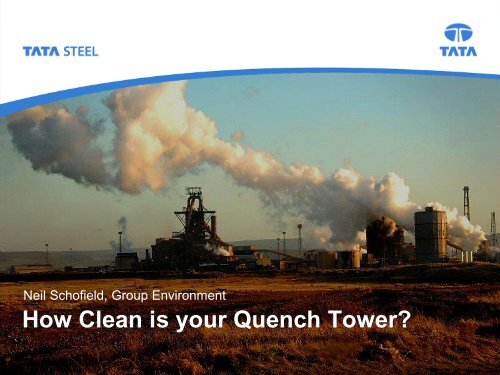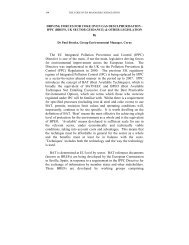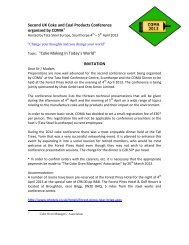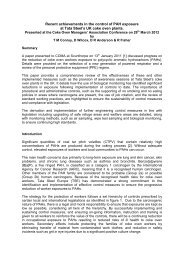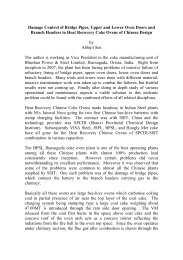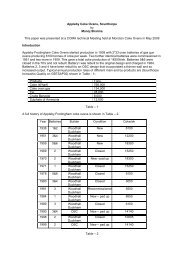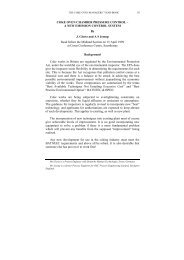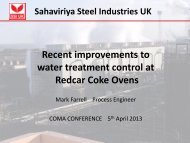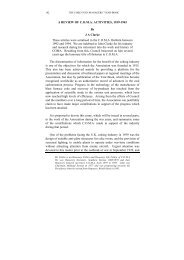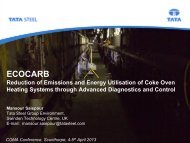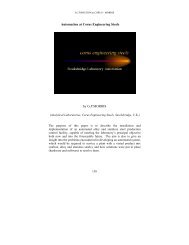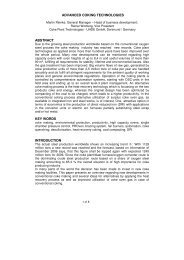How Clean is your Quench Tower? - Coke Oven Managers ...
How Clean is your Quench Tower? - Coke Oven Managers ...
How Clean is your Quench Tower? - Coke Oven Managers ...
You also want an ePaper? Increase the reach of your titles
YUMPU automatically turns print PDFs into web optimized ePapers that Google loves.
Neil Schofield, Group Environment<br />
<strong>How</strong> <strong>Clean</strong> <strong>is</strong> <strong>your</strong> <strong>Quench</strong> <strong>Tower</strong>?
<strong>Coke</strong>making in Today’s World<br />
HMIP or Alkali Inspectorate<br />
regulated, limits for stack<br />
em<strong>is</strong>sions based on the<br />
Alkali Act 1906<br />
Integrated Pollution Prevention and<br />
Control (IPPC). Introduces BAT and the<br />
BAT reference documents (first time<br />
quench em<strong>is</strong>sion range <strong>is</strong> documented in<br />
UK)<br />
Environmental Protection Act<br />
(EPA) aims to control and<br />
reduce pollution through<br />
author<strong>is</strong>ation of processes and<br />
tighter limits for stack em<strong>is</strong>sions.<br />
Introduces BATNEEC<br />
Industrial Em<strong>is</strong>sions Directive<br />
(IED). Rev<strong>is</strong>ion of BAT<br />
documents and introduction of<br />
BAT-AELs (associated em<strong>is</strong>sion<br />
levels)<br />
1980s 1990s 2000s 2010s<br />
2
BAT for coke quenching<br />
• Reduce dust em<strong>is</strong>sions by using one of the<br />
following techniques:<br />
• using coke dry quenching (CDQ) with the recovery<br />
of sensible heat and the removal of dust from<br />
charging, handling and screening operations by<br />
means of a bag filter<br />
• using em<strong>is</strong>sion-minim<strong>is</strong>ed conventional wet<br />
quenching<br />
• using coke stabil<strong>is</strong>ation quenching (CSQ)<br />
• BAT-AELs for dust are:<br />
< 20 mg/Nm³ (in case of CDQ)<br />
< 25 g/t coke (in case of wet quenching)<br />
• th<strong>is</strong> level <strong>is</strong> based on the use of the non-<strong>is</strong>okinetic<br />
Mohrhauer method (former VDI 2303)<br />
< 10 g/t coke (in case of CSQ)<br />
3
Mohrhauer method (former VDI 2303)<br />
4
Application of the Mohrhauer Method<br />
5
Some UK <strong>Quench</strong> <strong>Tower</strong> Em<strong>is</strong>sions<br />
Plant<br />
Coarse<br />
Particulate<br />
Em<strong>is</strong>sion<br />
(g/t coke)<br />
BREF Range
Loss of Stat<strong>is</strong>tical Life Expectancy (months)<br />
through exposure to fine particulate<br />
7
Measuring Total Particulate Matter (TPM)<br />
8
Application of TPM with Mohrhauer<br />
9
Total Particulate Results (Plants A and F)<br />
Plant<br />
Total<br />
Particulate<br />
Coarse<br />
Particulate<br />
(g/t coke)<br />
Fine<br />
Particulate<br />
Factor<br />
(Total : Coarse)<br />
A 56 12 (44) 5.3<br />
F 684 622 (62) 1.1<br />
Particle Size<br />
D<strong>is</strong>tribution of<br />
Total Particulate<br />
Size Cumulative %<br />
>PM10 100<br />
PM10 5.3<br />
PM2.5 5.0<br />
PM1 3.5<br />
10
Compar<strong>is</strong>on of Em<strong>is</strong>sions (Plants A and F)<br />
Plant A Plant F Plant A Plant F<br />
• Coarse • Fine • PM 10<br />
11
Total Particulate Results<br />
Plant<br />
Total<br />
Particulate<br />
Coarse<br />
Particulate<br />
(g/t coke)<br />
Fine<br />
Particulate<br />
Factor<br />
(Total : Coarse)<br />
A 56 12 (44) 5.3<br />
F 684 622 (62) 1.1<br />
D1 18 14 (4) 1.3<br />
D2 12 4 (8) 3.5<br />
• Factors affecting the em<strong>is</strong>sion of fine particulate<br />
• <strong>Quench</strong> tower height and design?<br />
• <strong>Coke</strong> and/or quench quality?<br />
• <strong>Quench</strong> water quality?<br />
12
Actions to comply with BAT-AEL<br />
• Investment in state of the art quench tower<br />
• Tall tower, multiple baffles, baffle spray cleaning<br />
• Reduction of suspended solids and soluble salts in quench water<br />
• Investment in alternative quenching technologies<br />
• No quench plume with CDQ, only abated stack release<br />
• Understand that level <strong>is</strong> applicable to coarse dust only<br />
• PM 10 <strong>is</strong> a minor component of the quench tower em<strong>is</strong>sion<br />
• Research into the range of fine particulate em<strong>is</strong>sions from quench towers in<br />
order to set an achievable level<br />
13
Summary<br />
• <strong>Coke</strong>making in today’s world <strong>is</strong> subject to ever stringent environmental<br />
regulation<br />
• <strong>Quench</strong> tower em<strong>is</strong>sions have recently become the focus of regulators<br />
and em<strong>is</strong>sion limit values are expected in the future<br />
• <strong>Quench</strong> tower em<strong>is</strong>sions are difficult and costly to achieve, and<br />
standard measurement techniques do not provide the full story<br />
• <strong>Quench</strong> tower em<strong>is</strong>sions have been undertaken in the UK to allow<br />
cost-effective investment dec<strong>is</strong>ions to be made<br />
14
Thank you<br />
Neil Schofield<br />
Knowledge Group Leader<br />
Environmental Engineering and Monitoring<br />
T +44 (0) 1709 825569 (direct)<br />
F +44 (0) 1709 825400<br />
M +44 (0) 7825 522343<br />
neil.schofield@tatasteel.com<br />
Tata Steel Group Environment<br />
Swinden Technology Centre<br />
Moorgate, Rotherham,<br />
South Yorkshire S60 3AR,<br />
United Kingdom<br />
15


